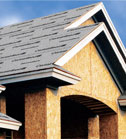After a major weather event, NRCA's Technical Services Section generally will experience a rise in telephone calls, especially from homeowners. Although most calls focus on questions about roof systems, there are numerous insurance-related questions and concerns. As a roofing contractor, you also probably receive questions from homeowners unsure how to proceed with roof system repairs or replacements following a storm, and it is important you stay informed of insurance-related issues so you can better help your customers.
Following are some common questions and issues that can arise when homeowners and roofing contractors work with insurance companies following a major storm. It is important to note some of the information provided in this article is based on my research of several major insurance companies that offer homeowners' insurance policies. The information does not necessarily represent or reflect NRCA's positions unless specifically stated.
A homeowner's roof system was damaged by a storm. How can he or she tell when to call the insurance company?
It is in a homeowner's best interest to contact his or her insurance company as soon as possible. A claims adjuster will inspect the condition of the roof system at no cost to the homeowner.
There are several options available to file a claim. Homeowners can call their insurance companies, contact their local insurance agents or brokers or file a claim online. Some companies, such as State Farm® and Progressive® Insurance, also have mobile apps through which subscribers can file claims. Insurance companies recommend homeowners document the damage with photos, especially if temporary repairs are going to be performed. It also is a good idea for homeowners to keep a record of when the damage occurred and what was damaged in addition to a detailed account of the claims process.
A homeowner doesn't agree with the settlement the claims adjuster offered him or her. Should the homeowner hire a third party, such as a roof consultant, to get another opinion?
A roof consultant can be expensive. In addition, an insurance company may not take the roof consultant's findings into consideration.
If a homeowner disagrees with an adjuster's findings, the homeowner first should let the claims adjuster know he or she is not happy with the settlement. If the adjuster won't negotiate, the homeowner can contact a claims manager to express his or her concerns. The homeowner probably will need to supply copies of all supporting documents.
If the homeowner and insurance company cannot reach an agreement, the homeowner can hire a public adjuster. Unlike claims adjusters who represent the interests of insurance companies, public adjusters work on behalf of consumers. Public adjusters' fees are based on a percentage of the insurance settlement, so they will try to get the maximum amount. As a general rule, retaining a public adjuster is for settlement cases involving larger sums of money and not for situations where small items, such as new sheet-metal flashings or static vents, are not covered.
It is important to note hiring a public adjuster is similar to hiring a roofing contractor. Homeowners should make sure the public adjuster is licensed and has references. The National Association of Public Insurance Adjusters provides information regarding insurance adjusters, as well as a list of its member companies, on its website, www.napia.com.
A homeowner also can see whether his or her state has acts and/or regulations regarding insurance claims. For example, California has an Unfair Practices Act and Fair Claims Settlement Practices Regulations included in its state code. The act protects consumers from unfair claims settlement practices, and the regulations govern how insurance claims must be processed.
Lastly, a homeowner can file a complaint with his or her state's insurance regulator, often referred to as the Department of Insurance. The National Association of Insurance Commissioners lists contact information for each state's insurance regulator on its website, www.naic.org.
An insurance adjuster says only the front half of a homeowner's roof system was damaged by a wind storm, so the homeowner will only get paid for half a new roof system. Is this typical?
As previously mentioned, a claims adjuster works on an insurance company's behalf, so it stands to reason he or she will prefer to pay for half a new roof system, and it's difficult to argue if the damage is limited to one side of the roof. Nonetheless, homeowners can contact their insurance companies if they want a claims adjuster to reconsider the assessment.
A hailstorm damaged the roof systems of several houses in a neighborhood. One homeowner's insurance company is saying her roof system does not need to be replaced, but some of the neighbors' insurance companies are paying for their new roof systems. Why does one homeowner get a new roof system and not another?
NRCA is unaware of any industry guidelines for evaluating hail damage. Generally speaking, a roof system is not considered damaged by hail unless its watershedding capabilities are affected and/or the roof system's expected service life is reduced. Factors that have an effect include number, size and hardness of hailstones; a storm's direction; roof slope; and a roof covering's age.
Insurance companies typically train claims adjusters to properly identify hail damage. An adjuster's assessment is based on his or her professional opinion, so it is possible evaluations may vary. I found one insurance company—State Farm—that offers a brochure that explains how to evaluate asphalt shingles for hail and other damage. This information helps educate State Farm's customers about how its claims adjusters evaluate different types of roof system damage.
As previously mentioned, if a homeowner does not agree with the findings of a claims adjuster, he or she can contact the insurance company and ask the evaluation be reconsidered.
A homeowner has a metal shingle roof system, and after a hailstorm, there were dents on a majority of the shingles. The insurance company says this is an aesthetic issue, so it will not pay to replace the roof system. Is this an accurate assessment?
When hailstones damage asphalt shingles, the granule surfacing gets displaced and the asphalt and/or reinforcing mat may become exposed to the elements, affecting the roof system's service life. Other types of hail damage include cracking or fractures.
Consequently, if the damage is considered extensive enough, the claims adjuster will recommend replacement. However, this is not the case with metal shingles. Dents or dimples in a metal shingle will not affect service life, and, therefore, are considered aesthetic issues. Most homeowner's insurance policies will not cover aesthetic issues.
A homeowner lives in an area prone to hailstorms and has had to replace his roof system twice. Is there a hail-proof roof covering he can put on the house?
Unfortunately, a truly hail-proof roof covering does not exist. Every type of steep-slope roof covering is susceptible to some degree of hail damage, and the roof coverings considered more hail resistant tend to be too expensive for most consumers. To address this niche market, some asphalt shingle manufacturers offer impact-resistant shingles.
There are two test methods frequently used to assess products' impact resistances: UL 2218, "Standard for Impact Resistance of Prepared Roof Covering Materials," and FM 4473, "Specification Test Standard for Impact Resistance Testing of Rigid Roofing Materials by Impacting with Freezer Ice Balls." Both tests categorize four levels of impact resistance classifications with Class 1 being the lowest level of impact resistance and Class 4 being the highest. A majority of available impact-resistant asphalt shingles are rated Class 4.
State Farm is one insurance company that offers its customers a premium discount for installing certain Class 4 asphalt shingles. Consumers who want to take advantage of the company's discount must live in one of the 26 states where the discount applies. More information is available at www.statefarm.com.
Additionally, NRCA and the Insurance Institute for Business & Home Safety (IBHS) offer two online programs to educate consumers and roofing professionals about impact-resistant residential roofing products and roof systems.
The first program, Impact-resistant Roofs: Contractor Certificate Program, is designed to help roofing contractors and their employees better serve their customers by building basic competencies for identifying, selecting, installing and selling impact-resistant roofing products.
The second program, Impact-resistant Roofs: Smart Steps to Reduce Hailstorm Damage, is free and teaches consumers the benefits of installing impact-resistant residential roofing products. More information about these programs is available at www.nrca.net/nrcauniversity.
It is important to note NRCA has concerns with impact testing because such testing might not replicate products' actual hail resistances. For additional information regarding NRCA's concerns, see "Concerns with impact testing," October 2008 issue, page 24.
You replace a hail-damaged roof system, which doesn't have an ice-dam protection membrane (it wasn't required when the roof system originally was installed). The local building code now requires an ice-dam protection membrane, so you install one on the new roof system. However, the homeowner calls you after the installation and says his insurance company won't pay for this "extra" installation. Is there anything you can do to help the homeowner?
It doesn't seem right, but unless there is language in the insurance policy that would cover items such as building code upgrades, the homeowner will incur a nonreimbursable expense. NRCA also has received calls regarding metal drip edge flashing, which is another item that was not required in older building codes.
You have a client whose roof system was damaged by hail, and the insurance company is willing to replace the entire roof system. The problem is the damaged roof system is the third layer of asphalt shingles on the house, and the adjuster only wants the damaged top layer to be removed and replaced. How do you convince the adjuster this isn't the proper way to do it?
Most building codes allow two roof systems maximum. NRCA can provide you with a copy of the language from the adopted building code to show the adjuster all the roof system layers that need to be removed to meet building code requirements.
You follow up with a homeowner to see whether she has any questions regarding your estimate. The homeowner tells you another contractor is offering a significantly lower bid so the homeowner can pocket some of the insurance claim money. Is this illegal?
It is considered insurance fraud if a homeowner profits from an insurance claim. A situation similar to this is when a homeowner receives a check for repairs and decides to not perform them and keeps the money instead.
Your competitor tells a homeowner he will waive the homeowner's deductible if he hires your competitor to replace a storm-damaged roof system. Essentially, your competitor is selling the homeowner a "free" roof system. Should the homeowner be suspicious?
This scenario preys on homeowners who cannot afford their deductibles or appeals to those who don't want to pay anything for a new roof system. Some roofing companies will propose to cut corners, offer an advertising agreement in exchange for payment (such as placing signs on the homeowner's lawn), pad the homeowner's bill or offer to take only what the insurer pays and not the deductible. These are not the practices of a reputable roofing company. An insurance company expects homeowners to pay their deductibles out of their own pockets. Depending on the circumstances, this practice could be considered insurance fraud.
Final words
After a storm event, you might be speaking with some confused homeowners. Try to stay informed of insurance-related issues so you can assist them. Advise homeowners to take photos, keep a log of telephone calls and conversations, and make copies of all paperwork and correspondence for their records. Also, tell homeowners to carefully read and understand all documents before signing and, most important, contact their insurance companies, agents and/or brokers directly if they have any questions or concerns.
Joan P. Crowe, AIA, is an NRCA director of technical services.
Did you know?
NRCA's website provides resources for consumers needing roof system repairs following storms, including NRCA's guidelines for selecting low- or steep-slope roofing contractors; a list of NRCA member companies by ZIP code, roof system type and radius; NRCA's and Chicago-based CNA's Emergency Planning Bulletin; NRCA's and IBHS' Impact-resistant Roofs: Smart Steps to Reduce Hailstorm Damage; and more. All resources are available in the Consumer section of NRCA's website, www.nrca.net/consumer.



